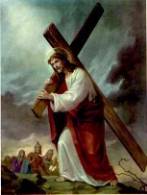To the Reader

Life can be very bitter at times. We can be overcome by pain, by suffering of all kinds, sickness poverty and loneliness. We can feel abandoned and alone, without support or anyone to whom we can turn. This can be a call from God to turn to him. We cannot leave our lives to God in the sense that we expect him to work miracles for us, but having done what we can to change things, then we can leave the rest to God. Remember always that great saying of St. John “It is not that we first loved God but that God first loved us”. God chose us in Christ before he created the world, and God will never abandon us. We are never merely alone – He is always there. We are all sinners but God still loves us and will never condemn us. Use this little book of prayers and it will bring you closer to God and to peace of heart and mind.
Approbation
These prayers were copied from a book printed in Toulouse in
1740 and published by Father Adrien Parvilliers of the Society of Jesus,
Missionary Apostolic of the Holy Land with the approbation, permission and
recommendation to spread the devotion.
At the time of St. Bridget in the XIV century, printing had not been invented
but recourse was had to copyists. Pope Urban VI encouraged the multiplication of the number of
copies of the revelations of St. Bridget, which Kings, Bishops, Universities,
Convents and Libraries were clamouring for.
The books containing these prayers and promises have been approved by a great
number of prelates among whom are His Eminence Cardinal Giraud of Cambria in
1845, Archbishop Florian of Toulouse in 1863.
The collection of small books, among which were these Prayers, was
blessed by his Holiness Pope Pius IX on May 31, 1862.
Finally, this collection was recommended by the Great Congress of Malines
on August 22, 1863. Those who visit the church of St. Paul at Rome can see the
natural size crucifix sculptured by Pierre Cavallini before which St. Bridget
knelt and the following inscription is placed in the church:
“Pendentis, pendente Sei verba accepit aure accipit et verbum corde
Brigitta Deum. Ano Jubilei MCCCL”, which recalls the prodigy with which
the crucifix conversed with Bridget.
ST. BRIDGET OF SWEDEN
In the centre of Sweden there is a placed called Vadstena
(situated beside Lake Vaetern). In
the Middle Ages Vadstena was a religious and cultural centre which radiated far
beyond its region. The patron saint
of the town is St. Bridget. She is
one of the most renowned personalities of Sweden.
Very well known are her revelations and prayers, the texts of which were
translated into Latin by her confessional priests. Fr. Petrus Olavi and Matthias of Linkoeping.
From these texts one can learn a lot about the time when Sweden became
Christian and as well it gives an insight into the lifestyle of Sweden of that
time. It gives a clear account of
how the women lived during the Middle Ages.
Interesting enough one can also find political information.
Most of all the Swedish pagan nobility criticized St. Bridget.
St. Bridget – who is of noble blood – married a country
judge called Ulf Gudermarsson. She
bore him eight children. Bridget
was a good wife who lived happily with her husband for 28 years. Her husband died after a pilgrimage to Santiago de Compostela
in Spain. St. Bridget was also a
good mother, she reared all of her children to lead holy lives.
King Magnus Eriksson gave St. Bridget a present of a country
estate called Vadstena, even though she sometimes made him uncomfortable with
her counselling. St. Bridget wanted
to erect a twin-convent on the grounds of the Bjaelbo Palace, but her patience
was put to trial. Due to internal
ecclesiastical disputes she had to wait for 20 years for the return of the Pope
from Avignon. Her wish was granted
shortly before her death in 1373. However,
her daughter Katarina in Vadstena took over from there to expand on the bulding
up of the Bridget Order. The relics
of St. Bridget are presently in the Gothic Convent Church in Vadstena, which was
built in 1430.
The Bridget Order has had a very moving past.
Due to the prosperity of the church during the reformation the kings lost
possession of the churches and convents. After
Carl IX had forbidden the Catholic religion the nuns of the Bridget Order were
also cast out of the country. In
1952 there was a constitutional change which allowed the Catholic religion to
enjoy the same rights as the State Church.
This made way for the return of the Bridget Order.
Today in Vadstena there exists another convent of the Bridget Order. Presently there are thirteen nuns living humble lives in a
building near the original convent. The
original convent is still in the possession of the State and is presently being
used as a hotel.